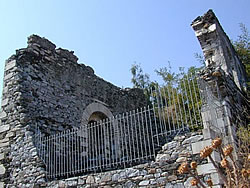 Monuments
Monuments
Across Ikaria ruins are scattered from all periods.
The archaeological findings are exhibited in the Archaeological Museum of St. Kirikos and the Museum of Kampos.
• Tauropolioen (Nas)
Ancient city inhabited by the Naiades. In antiquity it was one of the most
famous shrines, dedicated to Artemis Tauropolos. From the ancient harbor has survived until today the waterfront and the floor of the sanctuary. It is located west of Armenistis.
• Inoi
The ancient capital of the island. Also called Dionissiada. Traces of the wall that surrounded the city, and the ruins of the Byzantine Houses can be found. These findings are in today’s area of Kambos.
• Drakano
Ancient city that was the home of Dionysos. Located in the area of Faros the easternmost point of the island. Today only the ruins of an ancient castle and on the Tower of Drakano remain, dating back to Alexandrian reign of the 4th century B.C.
• Therme
Ancient city with re-known spas. They are today’s Therma Village.
• Koskina Castle
A Fortress from the Byzantine era, a work of the 10th century, near the village Kosoikia in the north of the island. Inside the fortress is the church of St. George Dorgana.
The village Glaredo, of the "Palioperivolo" district is a local settlement of the Neolithic era. Ruins of circular planed houses with stone foundation can be found here as well as homes with cobble floor and numerous shards of ceramic vessels and obsidian fragments. The diameter of these structures range from 3.70 m to 5.20 m
North of "Propezoulopi" and Drakano, a few kilometers from the "Sanctuary" bay and the cave, megalithic monuments can be found (Menhir). These columns from limestone, have either been staged in their original position or reclined to the ground. With their almost sharp tips, they have been arranged usually in groups in a straight line.
A makeshift museum in the village school Katafygi exhibits red vases, the copy of a grave stele and other findings. North of the citadel graves have been excavated from the Geometric period onwards. The tombs’ sides are lined with slate. In the graves are buckles and vases of the Geometric period, Corinthian kryvalloi, black and red-figure vases, mirrors and agricultural tools made of copper or iron.
On the northeast side of the hill of St. Irene are the ruins of the Roman conservatory. The area is covered by ruins of baths, reservoirs, pipelines and water sanitation. The archeological findings in this area are remarkable (statues, tombstone reliefs, inscriptions, coins, pottery, tools, etc.) and are on display in the Archaeological Museum of St. Kirikos.
In the village of Arethousa tombs of the 5th century B.C. were excavated.
|


